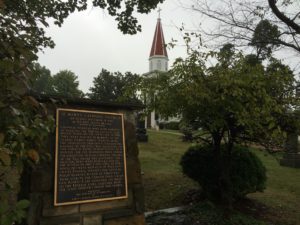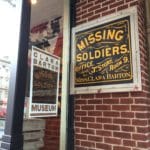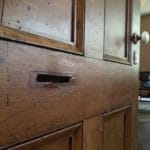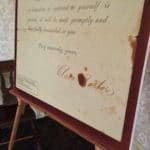Thomas Edison and the light bulb. The Wright brothers and flying. Clara Barton and the American Red Cross. We know the stories, and we happily live in the epilogue. But what about the prologue? The series of experiences that shape American legacies are often long-forgotten, but just as intriguing.
A group of Clara Barton aficionados descended on Washington, DC to seek out just that – what led Clara to the American Red Cross? I tagged along with the study tour to find out.
Clara Barton’s Missing Soldiers Office
The Missing Soldiers Office is, by far, my favorite piece of Clara history. From her persistent pleas to President Lincoln to endorse her efforts to her snarky response to a soldier who didn’t want to be found, this operation shows her tenacity and capability for incredible feats of work that changed the lives of many families.
The gallery above captures both Clara’s story, and the story of how this building was saved from demolition almost 20 years ago.
- A replica of the sign for Clara’s Missing Soldiers Office hangs outside the building on 7th St NW in Washington, DC. The original sign, found in 1996 by Richard Lyons in the building’s attic, helped identify the extraordinary significance of this former boarding house and helped save the building from demolition.
- While on a routine inspection for a building slated for destruction in 1996, Richard Lyons spotted an envelope hanging out of the ceiling slats. Upon investigating the attic, Richard stumbled on a treasure trove of items from the boarding house where Clara Barton ran her Missing Soldiers Office. Richard’s discovery helped save the building, which has been converted into a museum. He stands in what was at one time Clara Barton’s bedroom, and the room where he made his timely discovery.
- This ceiling opening and ladder represent the area where Richard Lyons saw an envelope sticking out of the ceiling slates, leading to the discovery of more than a thousand artifacts from Clara Barton’s time in the Missing Soldiers Office.
- Clara Barton paid 50 cents in 1865 to cut a mail slot in this door, allowing letters seeking missing soldiers to be delivered.
- A copy of a letter Clara Barton would have sent to friends or family seeking to locate missing soldiers after the Civil War. Clara’s Missing Soldiers Office was able to locate over 22,000 men
Aiding the Wounded at Fairfax Station
 The tour also visited Fairfax Station and St. Mary’s Church, where Clara, along with four assistants, nursed and fed wounded Civil War soldiers who were brought by train to Fairfax Station and the surrounding area. According to the Fairfax Station Railroad Museum‘s website: “[Clara] stated they were ‘a little band of almost empty handed workers, literally by ourselves in the wild woods of Virginia with 3000 suffering men crowded upon the few acres within our reach.’”
The tour also visited Fairfax Station and St. Mary’s Church, where Clara, along with four assistants, nursed and fed wounded Civil War soldiers who were brought by train to Fairfax Station and the surrounding area. According to the Fairfax Station Railroad Museum‘s website: “[Clara] stated they were ‘a little band of almost empty handed workers, literally by ourselves in the wild woods of Virginia with 3000 suffering men crowded upon the few acres within our reach.’”
Clara’s legacy is woven into our nation’s history in many more ways than I had ever expected. Anyone have other favorite Clara facts to share?
Want to read more about the study tour? Head over to the American Journal of Nursing for a deeper dive.





